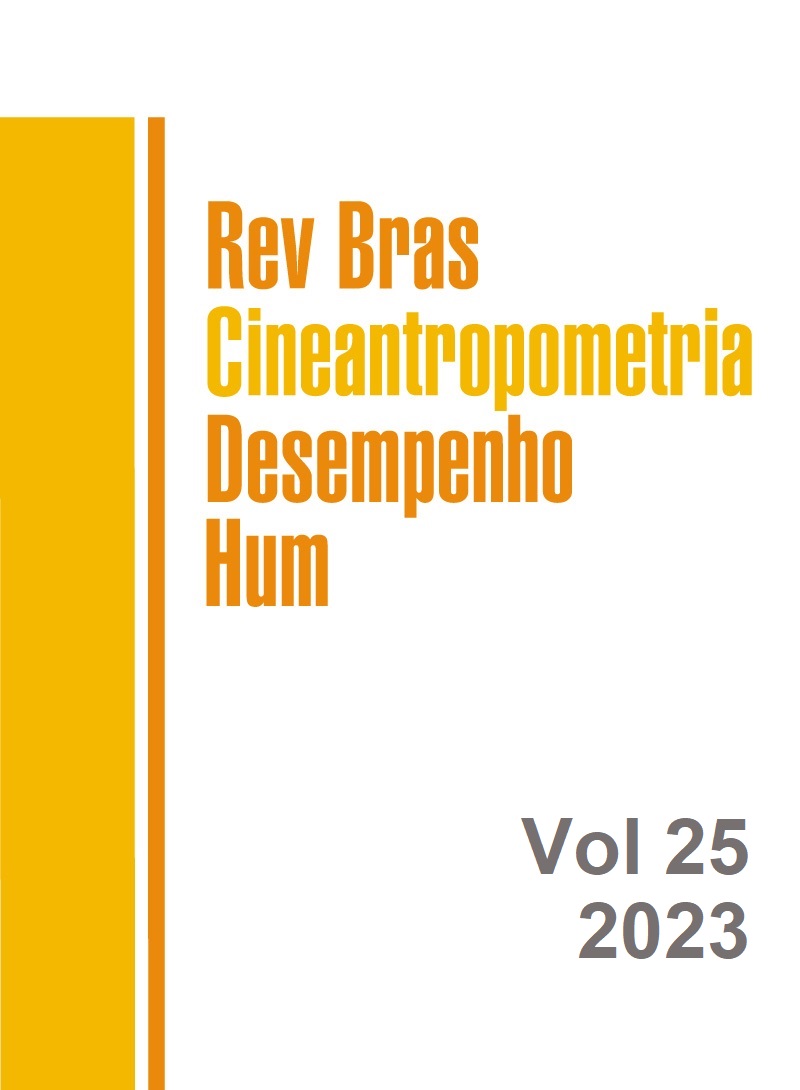Pinch size can affect the skinfold thickness measurement and interfere in the estimation and classification of body adiposity
DOI:
https://doi.org/10.1590/1980-0037.2023v25e90282Palabras clave:
Anthropometry, Body adiposity, Body compositionResumen
The aim of this study was to verify the effect of pinch size on skinfold thickness measurement and the consequent interference in the estimation and classification of body adiposity components. Cross-sectional and quantitative study carried out with a sample of 29 subjects recruited from a university in the city of Fortaleza, Ceará, Brazil. Four measurement steps were performed at each site of the eight chosen skinfolds. The first step was performed with a subjective-landmark and the three subsequent steps with fixed-landmarks defined with an expanding secondary line at 2 cm intervals. Body adiposity components were determined from the skinfold thickness measured at each landmark. Repeated measures ANOVA and Bland-Altman agreement analysis were applied. The subjective-landmark was chosen as the dependent variable. The 6 cm-landmark showed similarity and statistical agreement with the subjective-landmark for all skinfolds except the thigh, and with the sums of five and eight skinfolds. All fixed-landmarks showed agreement below the cut-off point for the percentile classification of subcutaneous adiposity and normative relative body fat. Variation in pinch size is an important source of TEM that can affect the reproducibility of skinfold thickness measurements and interfere in the estimation and classification of the molecular and tissue component of body adiposity.
Citas
Kasper AM, Langan-Evans C, Hudson JF, Brownlee TE, Harper LD, Naughton RJ, et al. Come back skinfolds, all is forgiven: a narrative review of the efficacy of common body composition methods in applied sports practice. Nutrients. 2021;13(4):1075. https://doi.org/10.3390/nu13041075
Ripka WL, Cintra-Andrade JH, Ulbricht L. A century of skinfolds for body composition estimation: what we learned? Rev Bras Cineantropom Desempenho Hum. 2022;24:e85412. http://doi.org/10.1590/1980-0037.2022v24e85412
Martin AD, Drinkwater DT, Clarys JP, Daniel M, Ross WD. Effects of skin thickness and skinfold compressibility on skinfold thickness measurement. Am J Hum Biol. 1992;4(4):453–460. https://doi.org/10.1002/ajhb.1310040404
Ruiz L, Colly JRT, Hamilton PJS. Measurement of triceps skinfold thickness: an investigation of sources of variation. Br J Prev Soc Med. 1971;25:165–167. https://doi.org/10.1136/jech.25.3.165
Hume P, Marfell-Jones M. The importance of accurate site location for skinfold measurement. J Sports Sci. 2008;26(12):1333–1340. https://doi.org/10.1080/02640410802165707
Esparza-Ros F, Vaquero-Cristóbal R, Marfell-Jones MJ. International standards for anthropometric assessment. Murcia: International Society for the Advancement of Kinanthropometry (ISAK); 2019.
Norton K, Whittingham N, Carter L, Kerr D, Gore C, Marfell-Jones M. Measurement techniques in anthropometry. In: Norton K, Olds T. Anthropometrica: a textbook of body measurement for sports and health courses. Sydney: UNSW Press; 1996. p. 57-59.
Brozek J, Keys A. The evaluation of leanness-fatness in man: norms and interrelationships. Br J Nutr. 1951;5(2):194–206. https://doi.org/10.1079/bjn19510025
Harrison GG, Buskirk ER, Carter JEL, Johnston FE, Lohman TG, Pollock ML, et al. Skinfold thicknesses and measurement technique. In: Lohman TG, Roche AF, Martorell R, editors. Anthropometric standardization reference manual. Illinois: Human Kinetics Publishers; 1988. p. 56.
Ross WD, Marfell-Jones MJ. Kinanthropometry. In: MacDougall JD, Wenger HA, Green HJ, editors. Physiological testing of the elite athlete. Illinois: Human Kinetics Publishers; 1982. p. 237.
Cameron N, Jones L. History, methods, and general applications of anthropometry in human biology. In: Muehlenbein M, editor. Human Evolutionary Biology. Cambridge: Cambridge University Press; 2010. p. 103.
Andrade JHC, Rodrigues BC, Uchôa FNM. Adiposidade relativa em adultos: comparação entre duas padronizações de medidas antropométricas. Rev Bras Nutr Esportiva. 2020;13(82):930-938.
Perini TA, Oliveira GL, Ornellas JS, Oliveira FP. Technical error of measurement in anthropometry. Braz J Sports Med. 2005;11(1):81-85. https://doi.org/10.1590/S1517-86922005000100009
Petroski EL. Development and validation of equations for estimating body density in adults. Rev Bras Ativ Fis Saude. 1995;1:89-91.
Siri WE. Body composition from fluid space and density: analysis of method. In: Brozek J, Henschel A, editors. Techniques for measuring body composition. Washington: National Academy of Sciences; 1961. p. 233.
Lohman TG. Advances in body composition assessment. Illinois: Human Kinetics Publishers; 1992.
Costa RF. Composição corporal: teoria e prática da avaliação. Barueri: Manole; 2001. p. 113-17.
Ludbrook J. Statistical techniques for comparing measurers and methods of measurement: a critical review. Clin Exp Pharmacol Physiol. 2002;29(7):527–536. https://doi.org/10.1046/j.1440-1681.2002.03686.x
Silva VS, Vieira MFS. International Society for the Advancement of Kinanthropometry (ISAK) global: international accreditation scheme of the competent anthropometrist. Rev Bras Cineantropom Desempenho Hum. 2020;22:e70517. https://doi.org/10.1590/1980-0037.2020v22e70517
Krämer HJ, Ulmer HV. Two-second standardization of the Harpenden caliper. Eur J Appl Physiol Occup Physiol. 1981;46(1):103–104. https://doi.org/10.1007/BF00422182
Schmidt PK, Carter JE. Static and dynamic differences among five types of skinfold calipers. Hum Biol. 1990;62(3):369–388.
Pastuszak A, Gajewski J, Buśko K. The impact of skinfolds measurement on somatotype determination in Heath-Carter method. PLoS One. 2019;14(9):e0222100. https://doi.org/10.1371/journal.pone.0222100
Burkinshaw L, Jones PRM, Krupowicz DW. Observer error in skinfold thickness measurements. Hum Biol. 1973;45(2):273–279.
Holmstrup ME, Verba SD, Lynn JS. Developing best practices teaching procedures for skinfold assessment: observational examination using the Think Aloud method. Adv Physiol Educ. 2015;39(4):283–287. https://doi.org/10.1152/advan.00044.2015
Stewart A, Marfell-Jones M, Olds T, Ridder H. International standards for anthropometric assessment. Lower Hutt: International Society for the Advancement of Kinanthropometry (ISAK); 2011. p. 60.
Edwards DA, Hammond WH, Healy MJ, Tanner JM, Whitehouse RH. Design and accuracy of calipers for measuring subcutaneous tissue thickness. Br J Nutr. 1955;9(2):133–143. https://doi.org/10.1079/bjn19550021
Descargas
Publicado
Número
Sección
Licencia

Direitos Autorais para artigos publicados nesta revista são do autor, com direitos de primeira publicação para a revista. Em virtude da aparecerem nesta revista de acesso público, os artigos são de uso gratuito, com atribuições próprias, em aplicações educacionais e não-comerciais, desde que seja dada a atribuição. Esta obra foi licenciada com uma Licença Creative Commons Atribuição 4.0 Internacional - CC BY


